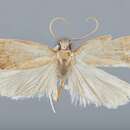Comprehensive Description
provided by Smithsonian Contributions to Zoology
Doina truncata
Alar expanse 16–22 mm.
Labial palpus pale buff suffused and irrorate with fuscous on outer surface of second segment; anterior and posterior edges of second segment very pale pink; third segment very sparsely dusted fuscous. Antenna buff, suffused fuscous. Head drab mixed fuscous and cinereous. Thorax light ochraceous buff. Forewing ground color light ochraceous buff shading to ochraceous tawny before a broad light buff terminal area; outer half of wing very sparsely irrorate with fuscous; on costa, just before apex, an ill-defined, tiny fuscous dot; along termen a series of 5 fuscous spots; lying on tornal edge a blackish streak; cilia drab. Hind wing pale grayish fuscous, paler basally; on termen three or four ill-defined fuscous spots and apical portion of wing speckled with fuscous. Foreleg pale buff; tibia suffused and irrorate fuscous; 1st tarsal segment with longitudinal orange-ocherous dash; midleg pale buff; femur and tibia suffused and speckled grayish fuscous; hind leg pale buff with a few scattered fuscous scales. Abdomen pale buff, suffused light ocherous posteriorly.
Male genitalia slide USNM 24256. Harpe ample, gently tapered to the rounded cucullus; base of inner surface clothed with a cluster of stout setae. Gnathos a spined knob. Uncus triangular; broad basally, tapering to a point posteriorly. Vinculum narrow U-shaped. Tegumen narrow, about as long as vinculum, finely scobinate laterally. Anellus a small sclerotized plate with large lateral lobes. Aedeagus short, stout, curved, bulbous basally; vesica armed with a few slender cornuti.
HOLOTYPE.—USNM 73704.
TYPE-LOCALITY.—Centro-Austral.
Described from the male holotype (Jan-Mar 1898, V. Izquerdo), and one female paratype (without abdomen), Lautaro (Nov 1895, V. Izquerdo).
The female is more ochraceous orange than the male before the buff terminal area.
In genitalia D. truncata is probably nearest to D. subicula but the pointed uncus of D. truncata immediately distinguishes it from D. subicula.
- bibliographic citation
- Clarke, J. F. Gates. 1978. "Neotropical Microlepidoptera, XXI : new genera and species of Oecophoridae from Chile." Smithsonian Contributions to Zoology. 1-80. https://doi.org/10.5479/si.00810282.273
Doina truncata: Brief Summary
provided by wikipedia EN
Doina truncata is a moth in the family Depressariidae. It was described by John Frederick Gates Clarke in 1978. It is found in Chile.
The wingspan is 16–22 mm. The forewings are light ochraceous, with buff shading to ochraceous tawny before a broad light buff terminal area. The outer half of the wing is very sparsely irrorated (sprinkled) with fuscous. On the costa, just before the apex, there is an ill-defined, tiny fuscous dot. Along the termen is a series of five fuscous spots and lying on the tornal edge is a blackish streak. The hindwings are pale greyish fuscous, paler basally. On the termen are three or four ill-defined fuscous spots and the apical portion of the wing is speckled with fuscous.
- license
- cc-by-sa-3.0
- copyright
- Wikipedia authors and editors

